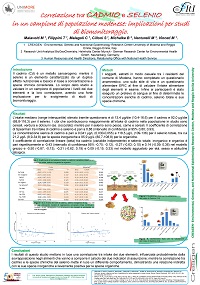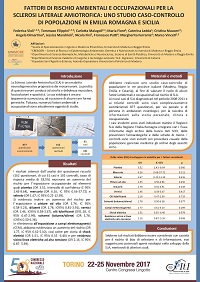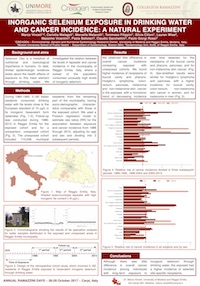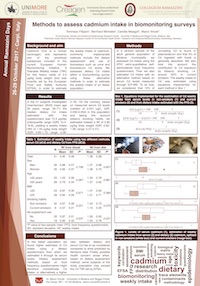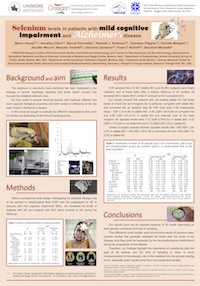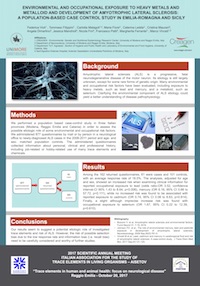Il cadmio (Cd) è un metallo cancerogeno, mentre il selenio è un elemento caratterizzato da un duplice effetto nutrizionale e tossico in base a concentrazione e specie chimica considerata. Lo scopo dello studio è valutare in un campione di popolazione i livelli dei due elementi e la loro correlazione, avendo una forte implicazione per lo svolgimento di studi di biomonitoraggio.
Poster: Fattori di rischio ambientali e occupazionali per la sclerosi laterale amiotrofica: uno studio caso-controllo di popolazione in Emilia-Romagna e in Sicilia
La Sclerosi Laterale Amiotrofica (SLA) è una malattia neurodegenerativa progressiva dei motoneuroni. La perdita di questi neuroni conduce ad atrofia e debolezza muscolare, fascicolazioni e spasticità. La sua eziologia è ancora largamente sconosciuta, ad eccezione di alcune rare forme genetiche. Tuttavia, numerosi fattori ambientali e occupazionali sono attualmente oggetto di studio.
Poster: Stima dell’assunzione settimanale di cadmio in un campione di popolazione italiana: metodologie a confronto
Il cadmio (Cd) è un metallo carcinogeno per l’uomo introdotto principalmente con la dieta nei soggetti non fumatori e non esposti professionalmente. La dose settimanale ammissibile di Cd è stata recentemente abbassata a 2,5 μg/kg di peso corporeo (bw) a settimana dall’Agenzia Europea per la Sicurezza Alimentare (EFSA) al fine di assicurare un alto livello di protezione per la popolazione. Nella presente indagine abbiamo messo a confronto due differenti modelli atti a stimare l’assunzione settimanale di Cd.
Original article: Magnetic fields exposure from high-voltage power lines and risk of amyotrophic lateral sclerosis in two Italian populations
Vinceti M, Malagoli C, Fabbi S, Kheifets L, Violi F, Poli M, Caldara S, Sesti D, Violanti S, Zanichelli P, Notari B, Fava R, Arena A, Calzolari R, Filippini T, Iacuzio L, Arcolin E, Mandrioli J, Fini N, Odone A, Signorelli C, Patti F, Zappia M, Pietrini V, Oleari P, Teggi S, Ghermandi G, Dimartino A, Ledda C, Mauceri C, Sciacca S, Fiore M, Ferrante M.
Amyotroph Lateral Scler Frontotemporal Degener. 2017 Jun 1:1-7. doi: 10.1080/21678421.2017.1332078
Abstract
The aetiology of amyotrophic lateral sclerosis (ALS), a rare and extremely severe neurodegenerative disease, has been associated with magnetic fields exposure. However, evidence for such a relation in the general population is weak, although the previous null results might also be due to exposure misclassification, or a relationship might exist only for selected subgroups. To test such a hypothesis we carried out a population-based case-control study in two Northern and Southern Italy regions, including 703 ALS cases newly diagnosed from 1998 to 2011 and 2737 controls randomly selected from the residents in the study provinces. Overall, we found that a residence near high-voltage power lines, within the corridors yielding a magnetic fields of ≥0.1 μT, was not associated with an excess disease risk, nor did we identify a dose-response relationship after splitting the exposed corridor according to the 0.1, 0.2 and 0.4 μT cut-points of exposure. These results were confirmed taking into account age at onset, period of diagnosis, sex, geographical area, and length of exposure. Overall, despite the residual possibility of unmeasured confounding or small susceptible subgroups not identified in our study, these results appear to confirm that the exposure to magnetic fields from power lines occurring in the general population is not associated with increased ALS risk.
Poster: Inorganic selenium exposure in drinking water and cancer incidence: a natural experiment
Selenium (Se) is a metalloid of nutritional and toxicological importance in humans. To date, limited epidemiologic evidence exists about the health effects of exposure to this trace element through drinking water. We investigated the relation between Se levels in tapwater and cancer incidence in the municipality of Reggio Emilia, Italy, where a subset of the population consumed unusually high levels of inorganic Se through drinking water.
Poster: Methods to assess cadmium intake in biomonitoring surveys
Cadmium (Cd) is a human carcinogen, and represents one of the prioritized substances included in the current European Human Biomonitoring Initiative. A Provisional Tolerable Weekly Intake (PTWI) for this heavy metal of 2.5 μg/kg body weight (bw) was recently set by the European Food and Safety Authority. To estimate the Cd intake, commonly used methods are dietary assessment and biomarkers such as urine and blood/serum Cd levels. We assessed dietary Cd intake in a biomonitoring survey using two alternative methods.
Poster: Assessment of selenium levels and risk factors for stroke and other cardiovascular disease: a cross sectional study in a seleniferous area of Punjab, India
Rural areas of Punjab in India have been found to have soil rich in selenium (Se); about 2160 hectare area is seleniferous and is populated by about 10,000 inhabitants. Selenium concentrations in these villages were reported to be as high as 65 times over non-seleniferous areas. The aim of this cross-sectional study was to evaluate selenium levels in blood, hair and nails in a group of subjects living in this area, and to evaluate the correlation between selenium exposure levels and a relevant cardiovascular risk factor and blood pressure.
Oral communication: Selenium in human neurodegenerative diseases: friend or foe?
Marco Vinceti, Tommaso Filippini, Carlotta Malagoli
Oral presentation at 2017 AISETOV Annual Meeting. Trace elements in human and animal health: focus on neurological disease.
Reggio Emilia (Italy), October 20, 2017
Selenium is a metalloid of considerable interest for human health, from both a toxicological and a nutritional perspective. However, the exact safe range of intake of this element as well as its health effects, including those on the central nervous system, are still unclear despite the large number of studies devoted to these issues in the last years.
Several laboratory studies have suggested a beneficial role of selenium in the prevention of the pathological processes underlying the onset of Alzheimer’s disease and Parkinson’s disease, possibly due to the antioxidant activity of selenoproteins. However, the relevance of these findings to the human is unclear. In addition, laboratory studies have also highlighted the neurotoxicity of several selenium species, probably due to their pro-oxidants effects, in sharp contrast with the well known antioxidant properties of selenoproteins.
Poster: Selenium levels in patients with mild cognitive impairment and Alzheimer’s disease
The exposure to neurotoxic trace elements has been implicated in the etiology of several neurologic diseases and some recent concern has focused the metalloid selenium (Se). Se may exists in several chemical species with markedly different and even opposite biological properties and both excess or deficiency of Se has been linked to Alzheimer’s disease. In this study we sought to evaluate the different interpretations that could be carried out depending on the time of sampling of Se.
Poster: Environmental and occupational exposure to heavy metals and metalloid and development of amyotrophic lateral sclerosis: a population-based case control study in Emilia-Romagna and Sicily
Amyotrophic lateral sclerosis (ALS) is a progressive, fatal neurodegenerative disease of the motor neuron. Its etiology is still largely unknown, except for some rare forms of genetic origin. Many environmental and occupational risk factors have been evaluated as risk factors, including exposure to heavy metals, such as lead and mercury, and a metalloid, such as selenium. Clarifying the environmental component of ALS etiology could yield a better understanding of disease pathophysiology.

